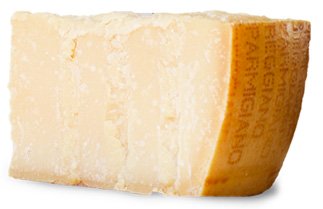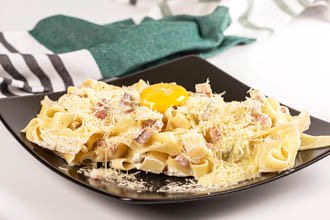Parmesan cheese
Parmesan cheese, also known as Parmigiano-Reggiano, is a popular hard, Italian cheese that is well-known for its rich, nutty flavor and distinct aroma. American generic Parmesan cheese is a type of cheese that is made in the United States and is modeled after Parmigiano-Reggiano.
Parmesan is a hard, dry, cooked-pressed, granular cheese. It is manufactured using partly skimmed cow's milk.
 |
| Parmagiano-Reggiano cheese. |
Preparation of Parmagiano-Reggiano cheese:
The production of Parmagiano-Reggiano is based on grass-fed milk from the Provinces of Parma. Other than milk, ingredients are only natural whey culture is allowed as a starter, together with calf rennet and salt solution for brining.
Procedure:
- Milk of the previous evening is held in large tanks to allow the cream to separate, resulting in a part-skim mixture, to which naturally skimmed milk of morning is added it.
- Starter whey (containing lactic acid bacillus) is added to this mixture and heated slowly to a temperature of 33-35 ° C for 10-12 minutes.
- At this point, add calf rennet. The mixture is left to curdle for 10-12 minutes.
- The curd is then broken up manually into small pieces (the size of rice grains), using a tool called spino.
- The cheese is put into a round form of stainless steel, so the cheese retains its wheel shape for 2-3 days and is kept at 16-18 ° C.
- The wheel is then put into a brine bath to absorb salt for 20-25 days at 16-18 ° C.
- After, the wheels are transferred to the aging rooms. the cheese is also turned every seven days at 18-20 ° C. It is allowed to mature for 12-30 months.
- The cheese is tested by a master grader who taps each wheel to identify undesirable cracks and voids within the wheel. Wheels that pass the test are then heat branded on the rind with the Consorzio Parmigiano-Reggiano's logo.
Characteristics of original Parmigiano-Reggiano cheese-
- The cheese is cylindrical, has a diameter of 35-45 cm the heel height is 20-26 cm, and weighs 30 kg. with straw yellow outer rind. The body of the cheese is fine-grained, and flaky in texture and the minimum fat content in dry matter is 32%.
- The cheese has a characteristic aroma and taste that are fragrant, delicate, and flavorsome without being pungent. The more mature the parmesan, the stronger the flavor, and the drier, crumblier, and grainier the texture.
Generic Parmesan cheese is the imitation of the family of hard, granular cheeses made from cow's milk, especially from original Italian Parmigiano-Reggiano or Grana Padano cheese. It is generally pale yellow in color, and less fruity flavorful than Italian Consorzio cheese. It has been aged a minimum of 10 months or more prior to conversion and packaging.
Health benefits of Parmesan cheese
Parmigiano-Reggiano cheese is an excellent source of several essential nutrients, including calcium, protein, phosphorus, vitamin A, and vitamin B12.
It is a rich source of high-quality protein, with about 35.8 grams of protein per 100 g (3.5 oz). Protein is important for various bodily functions, including building and repairing tissues, supporting immune function, and maintaining healthy hair, skin, and nails.
Parmesan cheese is a good source of calcium, with about 1180 mg of calcium /100 g (3.5 oz). Calcium is essential for building and maintaining strong bones and teeth, nerve function, muscle function, and blood clotting.
This cheese is a hard cheese that has a very low lactose content, making it more easily digestible for those who are lactose intolerant compared to softer cheeses. This makes Parmesan cheese a good option for individuals who have difficulty digesting lactose.
Parmesan cheese is made using a natural fermentation process that involves the use of bacteria cultures. These bacteria can potentially have probiotic properties, which means they may help support gut health by promoting the growth of beneficial gut bacteria.
Parmigiano is relatively low in fat compared to many other types of cheese. A one-ounce (28 grams) serving of Parmesan cheese contains about 7-8 grams of fat, with most of it being saturated fat.
It is a rich source of minerals other than calcium. 100 g of Parmesan cheese also contains 694 mg (99% of RDI) and 2.75 mg (25% of RDI) of phosphorus and zinc respectively. Phosphorus is important for the formation and maintenance of healthy bones and teeth. Zinc is important for the immune system and for wound healing.
Parmesan cheese is a good source of vitamin A, with about 481 IU per 3.5 ounces (100 g). Vitamin A is important for healthy vision, skin, and immune function.
It contains a variety of volatile flavoring chemical compounds that contribute to its unique aroma and flavor. Some of these compounds include Butyric acid, Isovaleric acid, Propionic acid, 3-methyl butanal, Diacetyl, and 2-methyl butanal.
It is important to note that Parmesan cheese is also high in sodium and saturated fat, so it should be consumed in moderation as part of a balanced diet.
| Principle | Nutrient Value | Percent of RDA |
|---|---|---|
| Energy | 392 Kcal | 20.5% |
| Carbohydrates | 3.22 g | 2.6% |
| Protein | 35.8 g | 64% |
| Total Fat | 25 g | 125% |
| Dietary Fiber | 0 g | 0% |
| Vitamins | ||
| Folates | 7 μg | 2% |
| Niacin | 0.271 mg | 1.7% |
| Pyridoxine | 0.091 mg | 7% |
| Riboflavin | 0.332 mg | 25% |
| Thiamin | 0.039 mg | 3% |
| Vitamin-A | 781 IU | 26% |
| Vitamin-C | 0 mg | 0% |
| Vitamin-D | 19 IU | 3% |
| Vitamin-E | 0.22 mg | 1.5% |
| Vitamin K | 1.7 µg | 1.4% |
| Electrolytes | ||
| Sodium | 1180 mg | 79% |
| Potassium | 92 mg | 2% |
| Minerals | ||
| Calcium | 1180 mg | 118% |
| Copper | 0.032 mg | 3.5% |
| Iron | 0.82 mg | 10% |
| Magnesium | 44 mg | 11% |
| Manganese | 0.02 mg | <1% |
| Phosphorus | 694 mg | 99% |
| Selenium | 22.5 µg | 41% |
| Zinc | 2.75 mg | 25% |
Buying
Buy aged parmesan from authentic sources. Look for the Parmigiano-Reggiano stamp on the rind of the cheese to ensure its authenticity. Parmigiano-Reggiano or Grana Padano is imprinted in dots on the rind along with the producer's number and the month and year of production.
Younger Parmesan (aged for around 12-18 months) has a softer texture and milder flavor, while older Parmesan (aged for 24 months or more) has a harder texture and sharper, nuttier flavor.
It should have a firm, dry, and "close" body.
Parmesan cheese should be firm and slightly grainy, with a crumbly texture. It should have a pleasant, slightly nutty aroma. Avoid If the cheese smells off or sour, it may not be fresh. Also, avoid cheeses that feel soft or rubbery.
Storing
At home, store Parmesan cheese in the refrigerator at a temperature between 32°F and 40°F (0°C and 4°C), away from moisture.
Keep it in its original packaging until you're ready to use it. Once opened, wrap the cheese tightly in plastic wrap or aluminum foil to prevent it from drying out.
Parmesan cheese can last for several months in the refrigerator if stored properly. However, it is important to check the cheese for any signs of mold or spoilage before using it.
It can also be frozen for longer storage up to 6 months. Wrap it tightly in plastic wrap or aluminum foil, and then place it in an airtight container or freezer bag. When ready to use, thaw the cheese in the refrigerator overnight.
Food uses
Parmesan cheese possesses a slightly fruity aroma and sweet taste that uplifts the flavor of any simple dish it is added to. It can be used grated in a wide variety of dishes, such as pasta, risotto, soups, and salads.
 |
| pasta- spaghetti with bacon, parmesan and yolk egg. Courtesy: Marco verch |
Parmesan cheese is a classic topping for pasta dishes, such as spaghetti with tomato sauce, fettuccine alfredo, or carbonara.
It can be added to risotto for a rich, creamy texture and nutty flavor.
It can be shaved or grated over salads for added flavor and texture. It pairs well with greens, such as arugula, and can also be added to Caesar salad dressing.
Parmesan rind can be added to soups and stews to add flavor and depth to the broth.
Grated parmesan over pizza for added flavor and texture.
It can be grated over roasted vegetables, such as asparagus or broccoli, for added flavor.
Parmesan cheese can be used to bread chicken or fish before frying or can be added to meatballs or meatloaf for added flavor.
Add it to creamy sauces, such as alfredo sauce or béchamel, for added flavor and richness.
Safety profile
Parmesan cheese has a generally good safety profile. One of the main safety concerns with this cheese is the potential for bacterial contamination, particularly from the bacteria Listeria monocytogenes.
Another safety concern with Parmesan cheese is the potential for allergic reactions in people who are sensitive to cow's milk. so, it is not suitable for people with a dairy allergy or lactose intolerance.
Strong cheeses, including parmesan, are high in tyramine content, and if a person on Mono-amine oxidase inhibitors (MAOI's) medication like Phenelzine (Nardil) consumes cheeses, he may develop a medical emergency known as "hypertensive (high blood pressure) crisis" which have symptoms like severe headache, sweating, nosebleeds, fast heartbeat, chest pain, blurring of vision, shortness of breath, and confusion, and should seek immediate medical attention. Also, they need to continue following a low-tyramine diet for a few weeks after stopping these medications. (Medical Disclaimer)
Source: Mayo clinic: MAOI's and diet.
Also read ≻≻-
≻≻- Cheddar cheese nutrition facts.
≻≻- American Cream cheese nutrition facts.
≻≻- Back to Dairy products from Parmesan cheese nutrition facts.
≻≻- Back to Home page.
Further Resources:
USDA National Nutrient Database. (opens in new window).
USFDA-Guidelines-CFR - Code of Federal Regulations Title 21 (opens in new window).
Parmesan cheese-Parmigiano-Reggiano guidelines. pdf. (opens in new window).